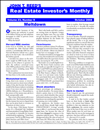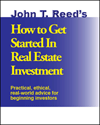John T. Reed’s review of Spencer Strauss & Martin Stone's book
The Unofficial Guide to Real Estate Investing


(This article first appeared in Real Estate Investor's Monthly.)
This book is written by two Realtors®: Spencer Strauss and Martin Stone. They are partners in Buckingham Real Estate Investments and Richmond Financial Services in El Segundo, CA. As you would expect from Realtors®, you get sweeping optimism, glib reassurances, and the Realtor® party line. They deviate somewhat from the Realtor® party line, but not much.
‘More than the official line’
The Unofficial Guides are a series like the “For Dummies” and “Complete Idiot’s Guide to” series. Their sophomoric slogan is, “For when you want more than the official line.” In the case of this book, it pretty much is the official line to the extent that there is such a line in real estate.
On the other hand, the book is refreshingly devoid of most get-rich-quick bull and takes a number of swipes at get-rich-quick real estate gurus—as all responsible real estate authors must nowadays. Other than the usual (for brokers) understating operating expenses and such, the authors give a pretty accurate, down-to-earth view of real estate investment.
Ever upward
They give the usual assurances that real estate values trend ever upward—“sure and steady”—to use their phrase. It ain’t that simple. Values go up and down—wildly in some property types.
Foreclosures, etc.
The authors recommend that beginners stay away from foreclosures, nothing down, and so forth. That’s probably good advice, although I would be more inclined to say that beginners can go into whatever area they want, but they’d better study harder—look harder before they leap—when it comes to stuff like foreclosures. I must also observe, perhaps overly cynically, that there are generally no commissions on foreclosures and that there often is no money to pay a commission in a nothing-down sale.
Positive cash flow
Their protestations to the contrary notwithstanding, the fantasy world of get-rich-quick gurus does make a few appearances in this book. According to Strauss and Stone, real estate investors get positive cash flow. First I’d heard.
They say one way to make sure you avoid negative cash flow is to charge market rent. No. Charging market rent is a sign of the most minimal management competence. You have to do much more than that to get positive cash flow—like buy the property for 60% of market value or pay all cash.
30% operating-expense ratio
They give an example on page 45 of a four-unit rental property with a 30% operating-expense ratio. In fact, operating-expense ratios are almost always around 45% and may be a bit higher on a four-unit because of the inability to employ a full-time manager or get any volume discounts. If you redid their example with a 45% operating-expense ratio, the property would show a negative cash flow, not the positive one they show.


My impression is that the run-of-the-mill rental property has negative cash flow if the buyer borrows 60% or more of the purchase price.
Gold watch
Much of the book is cliched discussion of investment. You can’t work 40 years for one company and get a gold watch and a pension anymore. (Could you ever? Wasn’t there a depression and a world war back in the era when that was supposedly possible?) “Buy land. They ain’t making it anymore.”
The authors attribute that to Mark Twain. I believe it was Will Rogers. It’s also wrong. Huge areas of the world that were under communist government control are coming onto the private land market. Plus “they” made a heck of a lot of it the first time around. Drive across the U.S. and tell yourself that stuff you are endlessly driving by is scarce. If you are not convinced at the end of your drive, go back across again through Canada.
Property managers
I recommend that you never use a fee-paid property manager. In-house property managers are OK. Realtors® typically say you must always use a property manager (the vast majority of whom are Realtors®). These authors say you should manage properties yourself initially so you can do a better job of supervising managers later when you hire them.
I agree, but I would do it to manage your salaried resident managers and in-house property managers, never a percent-of-the-gross, outside property manager. The problems with them are they almost invariably neglect your property and take kickbacks from suppliers and subcontractors who overcharge. They also use the most expensive contractors and suppliers because those guys are the least trouble for the property manager to work with.
FHA income-property finance
Technically, FHA has long offered financing on one-to four-family dwellings. However, as a practical matter, it is my understanding that it is virtually impossible to get such financing on three- or four-family buildings because of FHA demands for absurdly high debt-coverage ratios and their refusal to count all rent.
In other words, no three- or four-family building ever comes close to penciling out by FHA rules. Yet the authors give an example of buying a four-unit FHA deal for $300,000 with just $9,000 down. And these guys are from Southern California—where some houses require $300,000—down!
Tax benefits
The authors are very glib about the tax benefits of real estate investing. According to their page 24, “…you are allowed to deduct your losses from operating expenses on your federal taxes.”
The more complete, more accurate statement would be, “If you are in the real estate business full-time or most-time, you can deduct rental property losses on your taxes. If your are not in the business full or most time, your ability to deduct losses will be limited or eliminated depending upon your non-real estate adjusted gross income.
The phrase “passive loss limits” does not appear in the book’s index, although “passive investor” does and the limits are finally explained in that section on page 224.
Inflation
As you would expect, these Realtors® love inflation and explain that it makes your property value and rent go up. They do not mention that it does the same to your expenses and that inflation and property values sometimes deviate or even go different directions.


Taking back a loan
Also, as you would expect of Realtors®, they are big on seller financing—which makes their jobs easier. It lets you defer the taxes due on your gain and earn interest they explain. They are less forthcoming regarding how you defer the taxes (by deferring receiving the money yourself) and the fact that the interest rate on seller take-back, income-property mortgages is almost invariably well below what it should be given the risk of the mortgage.
Past is ‘often’ prologue
Every investment prospectus says words to the effect that “Past performance is not necessarily indicative of future performance.” The authors of this book say, “Although past history is no guarantee of the future, it is often a prologue and therefore is a better way to make an estimate than picking one out of thin air.”
Not so. Either past price trends predict future ones or they do not. The authors admit the truth—they do not. But they try to spin it so they can have it both ways: deniability that they said the past is predictive, while encouraging would-be income-property buyers to rely on the past. In fact, relying on the past is NOT a “…better way to make an estimate [predict the future] than picking one out of thin air.”
‘No skill’
I once interviewed the head of what used to be called the Weather Bureau regarding an analogy I was drawing between weather forecasting and appreciation rate forecasting. He readily discussed the accuracy of one-to five-day forecasts, but when I asked about forecasting farther than five days he said, “We have no skill at forecasting more than five days hence.”
I was struck by the starkness of that phrase “no skill” and tried to draw him out on longer forecasts. Again and he again, he repeated “We have no skill.” The fact is real estate investors and Realtors® have no skill at forecasting property appreciation rates. None. Nada. Zip. How could they? So many totally unpredictable factors like interest rates determine values.
The problem is they won’t admit they have no skill. Instead, they make mindless statements, like, “you have to go on something.” No, you don’t. No skill, period.
Chamber of Commerce
The authors repeatedly refer readers to their local Chamber of Commerce for information. I have written articles admonishing investors to, “Beware the Chamber of Commerce speech.” That is the list of local advantages and upcoming construction that makes every little Podunk sound like the future center of the universe.
The Chamber of Commerce is a great place for those looking for good news about the local economy—like Realtors®. It is not a very good place for comprehensive, balanced, objective information. I recommend sources like the Bureau of the Census for the sort of information these guys are telling you to get at the Chamber.
Vacation homes
The authors say you can use IRC §1031 to exchange vacation homes tax-free. Excuse me. On page 27 they say, “The best news is that you can probably use the 1031 tax-deferred exchange to shelter you profit [on a vacation home].” On page 156, they say, “…if these properties are purchased with the intent to sell some day at a profit, they qualify for the benefits of a 1031 exchange” and “…a vacation home qualifies for an exchange even if it isn’t rented and is only used for personal enjoyment.”
I believe that’s dead wrong. According to J.K. Lasser’s Your Income Tax (¶31.3), “The property exchanged must have been held for productive use in your business or for investment… Therefore, trades of property used…for personal purposes…such as a residence…cannot receive tax-free treatment.”
In their discussion of the requirements of a 1031 exchange on page 227 and 228, the authors list three “rules to qualify for a tax-deferred exchange:” “like kind” property, equal or greater value, and no boot.
They make no mention of the “productive use in business or for investment” requirement.


The phrase “for investment” can include raw land, but I have never heard it applied to a home that “…isn’t rented and is only used for personal enjoyment” as the authors claim. The main reason I cite this is to show that books that are sold in book stores, have beautiful print jobs, no typos, and say things like “second edition” and “more than 4 million unofficial guides sold,” can nevertheless contain advice that is total garbage.
‘What’s stopping you?’
The book has a chapter that is rare in such books. It’s called “So what’s stopping you?” (I have a similar discussion in my How to Get Started in Real Estate Investment.) It addresses the various fears that keep beginners from beginning or buying their first property. It’s a decent chapter.
This book is generally a good, comprehensive discussion of real estate investment. It is full of Realtor® bias and the sort of fuzzy thinking that is common among run-of-the-mill investors and agents. As long as they heed that proviso, it is a useful book for beginners.